Dec
18
2009
or The Crash of AD70
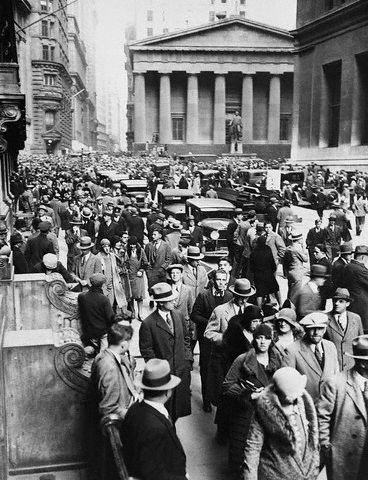
Now a river went out of Eden to water the garden, and from there it parted and became four riverheads. The name of the first is Pishon; it is the one which skirts the whole land of Havilah, where there is gold. And the gold of that land is good. Bdellium and the onyx stone are there. The name of the second river is Gihon; it is the one which goes around the whole land of Cush. The name of the third river is Hiddekel; it is the one which goes toward the east of Assyria. The fourth river is the Euphrates. (Genesis 2:10-14)
After the Herod and Shylock post, I had one complaint that the Worship as Commerce tag didn’t really do what it said on the tin, so I hope to capture it (briefly?) here. Now, where to start? As James Jordan explains, the idea begins in Eden.
Continue reading
1 comment | tags: AD70, Amalek, Gehenna, Genesis, Gnosticism, Herod, High Priest, Isaiah, Manna, Moses, Numbers 5, Revelation, Solomon, Temple, Worship as commerce | posted in Against Hyperpreterism, Biblical Theology, Christian Life, Creation, Ethics, Quotes, The Last Days, Totus Christus
Sep
8
2009
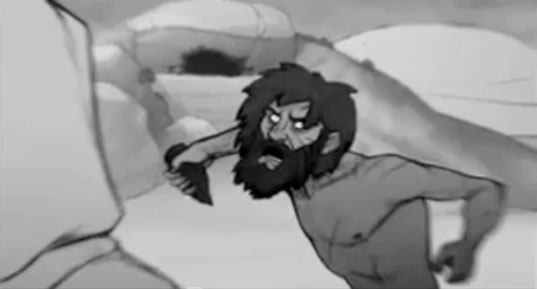
Matthew 1-10 follows the Dominion pattern. After Jesus’ testing in the wilderness, in 4:18-8:13 Jesus called His disciples and began mustering a new holy army – the “next generation”.[1] It was reported to Him that the last Old Covenant Nazirite (holy warrior) was dead. It was time for new warriors. Jesus healed the uncleanness of many, creating a new priesthood. His success in the wilderness as a new Head made possible this new body. Peter Leithart writes:
Continue reading
Comments Off | tags: Atonement, Bible Matrix, Demons, Dominion, High Priest, John the Baptist, Leviticus, Nazirite, Peter Leithart, Totus Christus | posted in Biblical Theology, Totus Christus
Aug
14
2009
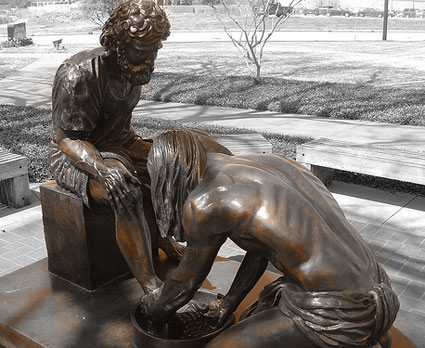
or Filling Up That Which is Lacking
After reading about the Bible’s use of robes as symbols of office (see The Dominion Trap by James B. Jordan), Tim Mitchell commented:
In Bible study we’ve been looking at John, so a few weeks ago was John 13. My Bible translated v.4-5 as “So he got up from the table, took off his robe, wrapped a towel around his waist, and poured water into a basin. Then he began to wash the disciples’ feel, drying them with the towel he had around him.”
So that recalled for me the couple of pages on robe imagery, and it seems to foreshadow what Jesus will do later on very well: He is willing to take off his authority and righteousness, and take on the dirt of our sin.
But then I got a bit unsure, since Jesus then goes on to say “you ought to wash each others’ feet” in v.14 and “Do as I have done to you” in v.15. So if the symbolism applies, how are we also supposed to take other peoples’ sin on us as Jesus did?
Firstly, what a great question. Many New Testament passages become so familiar that we often lose the ability to really think about their ramifications.
The structure of the Last Supper puts this action of Jesus at Atonement, the Laver (Day 6). Jesus is liturgically pre-enacting His role as High Priest. The Adam removed his glorious robes and wore linen for the Day of Covering. Jesus left this in the tomb with our sin on it. But that is not all the High Priest did. He approached the Most Holy twice.
Continue reading
Comments Off | tags: AD70, Against Hyperpreterism, Ahasuerus, Atonement, Daniel, Esther, Hebrews, High Priest, Holy Place, Joseph, Last Supper, Liturgy, Totus Christus | posted in Biblical Theology, Christian Life, Totus Christus
Jul
28
2009
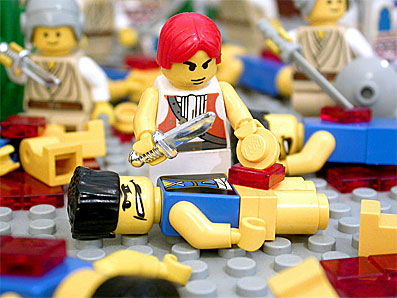
How smart is this Book?
As discussed, if we begin with Saul’s anointing by Samuel, subsequent events follow the Feasts outline. Saul’s failure to kill Amalek is at Pentecost and his failure to defeat Goliath is at Atonement.
BUT… if we begin with David’s secret anointing by Samuel, subsequent events also follow the Feasts. This time, however, David’s slaying of Goliath is at Pentecost (the serpent/beast in the wilderness). Guess what’s at Atonement?
Continue reading
1 comment | tags: Amalek, Bible Matrix, Circumcision, David, Eglon, Ezekiel, Feasts, goliath, High Priest, Saul, Sidon, Systematic typology, Tabernacles, Tyre | posted in Biblical Theology
Jul
27
2009
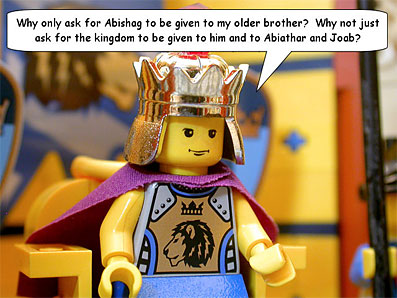
Eli’s corrupt priesthood came to an end when the Ark was taken by the Philistines. Saul’s corrupt kingdom came to a full end when the Ark returned (hence Michal’s barrenness). The last of Eli’s priesthood (Abiathar) was exiled when Solomon’s government began. Solomon’s kingdom was a new firmament (1 Kings 10:19). Isaiah, however, saw it being rolled up like a scroll (Is. 34:4).
Continue reading
Comments Off | tags: Abiathar, AD70, Ark of the Covenant, Caiaphas, Cyrus, David, Eli, Feasts, High Priest, Literary Structure, Saul, Solomon, Systematic typology, Zechariah | posted in Biblical Theology, The Last Days
Jul
26
2009
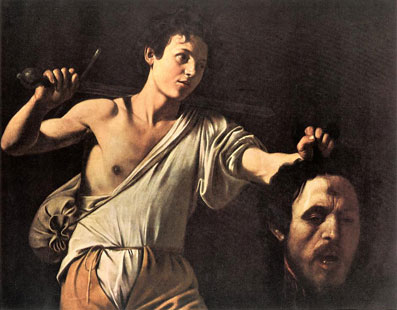
“In the sweat of your face you shall eat bread till you return to the ground…” (Genesis 3:19)
The book of Judges continually uses the imagery of the crushing of the heads of the Lord’s enemies, whether this is literal skulls or heads of state. The Bible makes a big deal of heads and bodies, whether this is the sacrifices picturing the totus Christus, or His rival, Gog and Magog.
Continue reading
Comments Off | tags: Atonement, David, Gethsemane, goliath, High Priest, Moses, Typology, Uzziah | posted in Biblical Theology
Jul
15
2009
or Limited Redemption
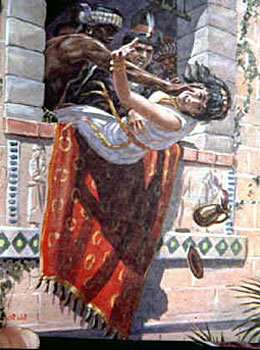
“For if we sin wilfully after that we have received the knowledge of the truth, there remaineth no more sacrifice for sins” - Hebrews 10:26
NOTE: THIS POST HAS BEEN REMIXED AND INCLUDED IN GOD’S KITCHEN.
Did Christ die for all? If Jesus’ blood was not shed for all, how can it possibly be a sin to “trample it underfoot” as the unbelieving Jews did? (Hebrews 10:29)
Elijah set up a 12 stone altar as a substitute for Israel. The sacrifice ascended to the Lord (goat #1) and the prophets were slain (goat #2). Thus, the Baal worship was atoned for.
But Jezebel trampled this sacrifice underfoot, and continued in sin. In retaliation, she slew the prophets that Obadiah had hidden. Consequently she was trampled underfoot. (2 Kings 9:33).
The New Testament history, including the Revelation, follows this pattern. Jesus set up a new 12 apostle priesthood and Israel slew Him and them. Consequently, Israel was slain, as Jezebel. That is the context of the Hebrews passage, and the meaning of the harlot of Babylon.
Continue reading
Comments Off | tags: Ark of the Covenant, Atonement, Calvinism, High Priest, James Jordan, Jezebel, Postmillennialism, Revelation | posted in Biblical Theology, The Last Days
Jun
7
2009
A couple of brave readers of my book Totus Christus have pointed out an apparent discrepancy in my ordering of the above three roles. One kindly writes:
The only question of substance I have for you concerns the prophet, priest and king flow of OT history. It may be that you disagree with Jim, but he’s quite insistent that the proper order is priest, king, prophet. He discusses this in From Bread to Wine, p. 9-15. In any case, it might be helpful to explain why you deviate…
Continue reading
Comments Off | tags: Aaron, David, Dominion Theology, High Priest, James Jordan, Moses, Music, Solomon | posted in Biblical Theology, Totus Christus
May
26
2009
[This has been posted previously but it makes sense to include it under this banner. In fact, the article itself might now make more sense!]
Gold, Onyx and Bdellium
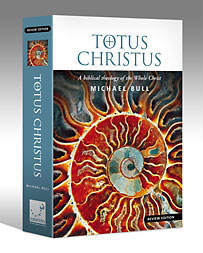
(The Tabernacle imagery is as much fun as it is grand and terrifying. I was thinking about rainbow striped onyx. In “Behind the Scenes”, James Jordan wrote:)
“These glorious gems represent the sons matured into tribes. A baby has not yet matured into anything specific. We don’t know if a child will become a good person or a bad one. We don’t know if he will be a musician or a minister or a farmer or a sailor or a computer engineer. As we grow, we grow from being “striped onyx” into a specific glory, which each of us has unique to himself. Thus, as the twelve sons of Jacob matured into tribes, each tribe took on a distinct glory of its own, represented by its gemstone.” Continue reading
Comments Off | tags: High Priest, James Jordan, Revelation, Totus Christus, Worship as commerce | posted in Biblical Theology, Totus Christus
May
20
2009
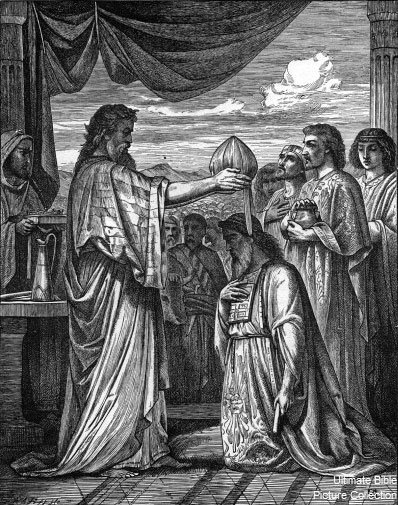
Leaving Wilderness Behind
In Through New Eyes, James Jordan notes that the wilderness was Havilah, the place mentioned in Genesis 2 that was rich in raw materials. Israel stripped Egypt of her gold, then plundered the desolate places of hidden wealth. She came out of the desert with a High Priest clothed in gems, and a new generation of soldiers born of God’s threshing floor.
The manna began to fall just after the Hebrews’ victory over Pharaoh. As with Jacob, the Lord was faithful to provide for His chosen one. But perhaps, in covering the ground, there is also the idea of a firmament (this might sound strange to some readers, but I have found the concept is a frequent one). The wilderness is the place of the humble bread of priesthood, displayed in obedience to God. It was the next generation that would drink the wine of Canaan after obedience under Joshua.
A Memorial
The Lord commanded that some manna be put into the Ark as a memorial. Symbolising manna, the white stone is a memorial of faithful priesthood. Joshua’s crossing of the Jordan was memorialised by large, engraved, white stones.
Continue reading
Comments Off | tags: Ark of the Covenant, Atonement, bdellium, Cain, Crucifixion, Ezekiel, Haman, Havilah, Herod, High Priest, James Jordan, Table of Showbread, Talmud, Urim and Thummim, White stone, Zechariah | posted in Biblical Theology, The Last Days


































